Anki Again Not Going to Learning
I take slaved over perfecting my Anki settings. I spend about three-5 hours on Anki every day. I started doing Anki religiously in November of 2019, which is about 2,300 hours on Anki. That'southward crazy. I know information technology's crazy though. And so If I am this crazy, and spending this much of my precious life with Anki, I better be using it as best as I can.
If you want to just skip to screenshots of my settings just click hither.
I take found the settings, that I think, work best. These settings avoid "Ease Hell," optimize memory inside a ane-2 year time period (the first 2 years of medical school), and prevent excessive card buildup. Also, I take tried to tinker with these settings for understanding as opposed to memorization . I want to sympathise, non memorize, these cards.
In this postal service, I volition show you lot every one of my Anki settings and the explanation behind each one equally well.
If you are completely new to Anki in Medical schoolhouse I have a mail on setting upwardly Anki with the AnKing for the outset time here.
- General Settings
-
- Basic
- Scheduling
- Network & Fill-in
-
- Deck Settings
-
- Background Information
- New Cards
- Reviews
- Lapses
- General
- Fuzz Factor
- Final Tips
-
- Pictures of My Recommended Settings For Medical Schoolhouse
General Settings
Equally a disclaimer, these are just the settings I take found to piece of work best for me in medical schoolhouse. These may not be optimal settings for learning other things such as a new language or for how you learn individually. At that place are no "perfect" settings. Y'all should read this post to get a skilful agreement of what the Anki settings and algorithms mean and "good" settings to commencement off with. Then, play around with them to match your learning style.
My settings are adjusted from the AnKing's, Conaanaa's, and MedShamin's guides. I noticed, about half-dozen months in that sure settings weren't working out also for me, similar the "again" setting and max-time interval. I adjusted those to work for me. This is a long, simply I remember fairly helpful post. Buckle in.
Allow's start with preferences.
To access preferences go to:
Peak Toolbar → Anki → Preferences
Basic
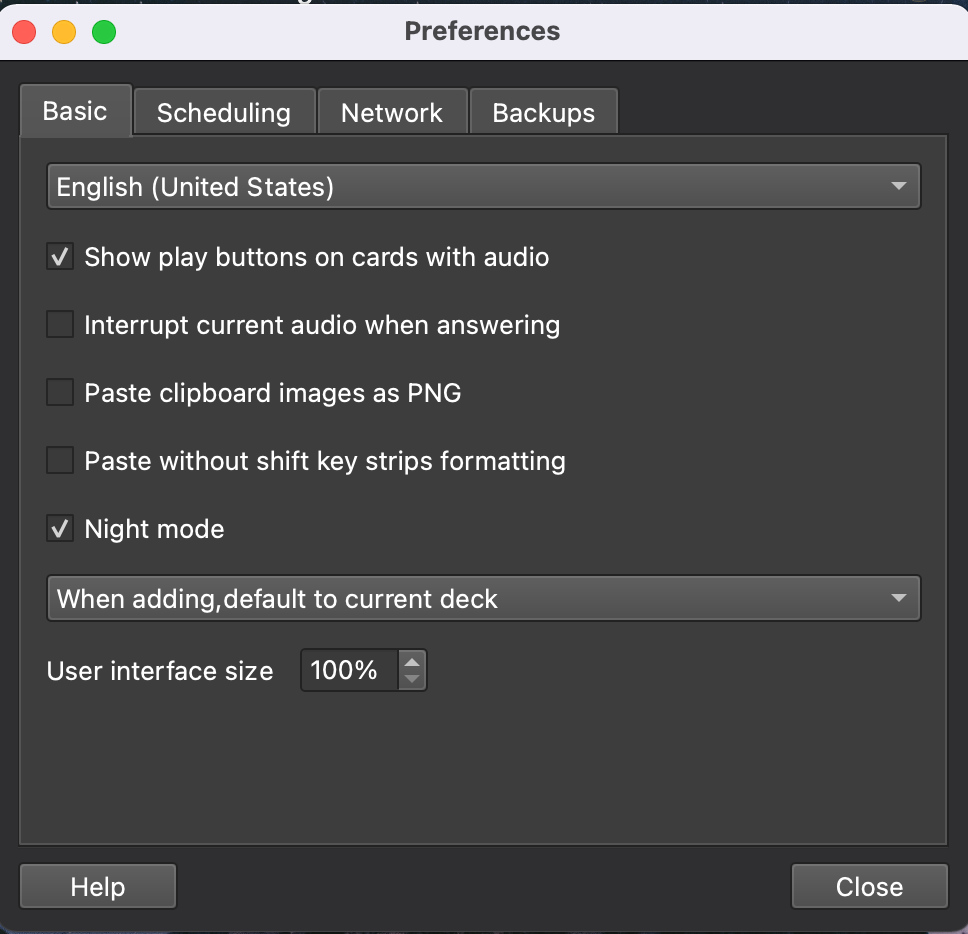
The only thing worth mentioning here is "Night Mode." This setting makes my deck take a gray groundwork normally with white text. Night mode means certain things about my Anki volition look different, every bit shown on my Anki below:
If y'all desire a guide on how to customize your Anki background click here.
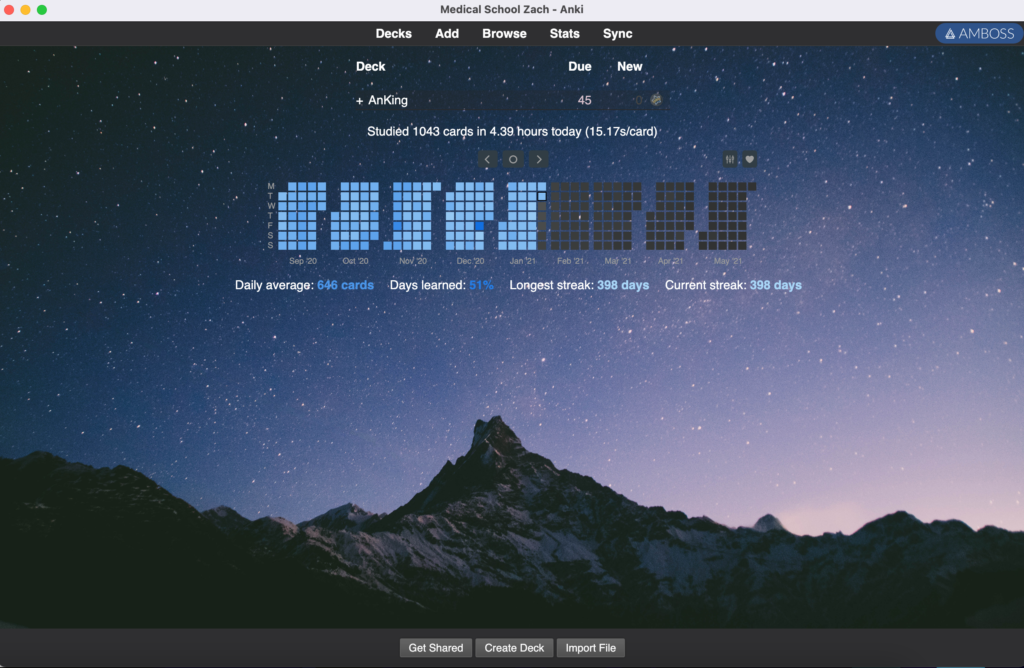
Scheduling
This is the nigh important section in preferences.
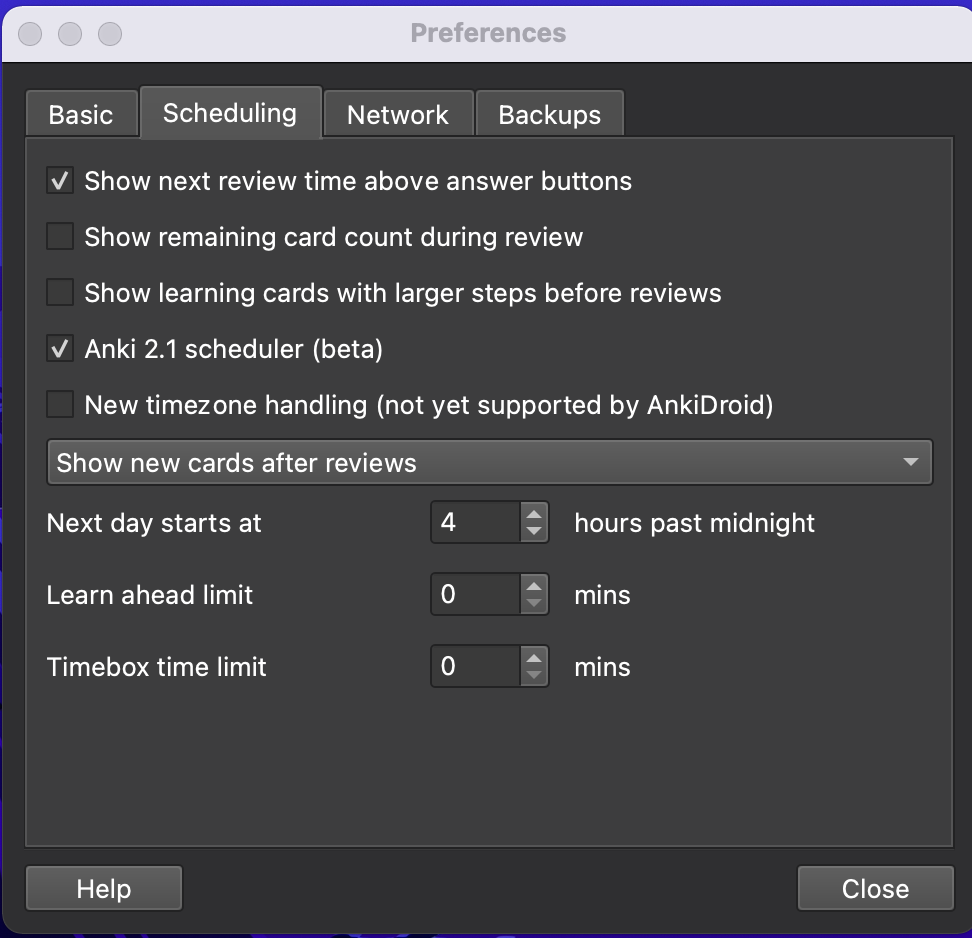

"Evidence next review fourth dimension in a higher place answer buttons" is the difference between this:

and this:

I retrieve it'southward better to get out it enabled then you tin can monitor to see if Anki is doing anything funky with your review times. Besides, it's benign to know how far in the time to come your cards are beingness pushed if you have an exam coming up.
For example, my Step 1 examination is in 2 months, so I know if I see "3 months" on the "good" button, I better know that card considering I won't be seeing it again before I accept my exam.

I leave "show remaining card count" unchecked. I feel that it is distracting and makes it more virtually smashing through the number of cards than understanding the data.
I find myself staring at that number.
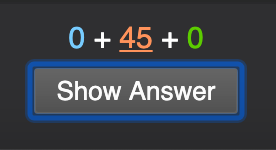
The but other one worth mentioning is the 2.1 scheduler beta. I enable this setting. Some benefits of this (a full list of changes tin can be found here):

- Reviews show upward in random order (This is the about important alter, in older versions of Anki reviews would testify upwards in order. I do not retrieve that is best for reviewing information for an exam. How will we be tested, in order? Probably not, allow'south mimic examination day every bit much as possible and have our reviews show up in random lodge).
- Filtered decks work much better (cards stats don't reset when edifice or deleting decks)
- Suspending/burial cards doesn't affect learning steps
- Learning cards now have a "hard" button, this is just the boilerplate of your "once more" and "proficient" learning step. So my "once more" stride is fifteen minutes and my "practiced" footstep is ane day and so my "hard" pace is ~12 hours.

The next setting is the order of cards to be shown. I select "Evidence new cards later on reviews."

This is considering I want to review all of the information that settled in my brain overnight outset. So I will learn any new cards leftover from the twenty-four hours before. Then I will learn the new content for today from third-party content, unsuspend those new cards, then written report them.
You tin can check out my daily study routine here.
Finally, I have the "new day" start at iv am. This is the time at which the "next twenty-four hours" is registered by Anki. That ways cards that are destined for the adjacent calendar day appear at iv am that day. If you study late into the night or start studying really early in the morn, y'all might want to change this setting. I am never upward by 10 pm studying, and never up before five am. And so I set it for 4 am.

The concluding setting worth mention hither is the learn alee limit. This ways if Anki pushed a card 15 minutes into the future, every bit it what happens for me when I hit "once more," if the "learn ahead limit" is xv minutes, I could review information technology at present (0 minutes afterwards hitting "again"). However, if information technology is set at 0, as mine is, I have to wait that 15 minutes before I meet this card.
I would never modify this setting unless you are trying to go through these cards before bed, or need to become through the cards in a brusk corporeality of time for some reason.

When you mess with this setting you are messing with the algorithm. Nosotros want to minimize that equally much equally possible. We like the Anki algorithm.
The final setting seems like Anki's endeavor at a Pomodoro built-in timer, or some sort of timer. It isn't that nifty. It just will tell y'all how many cards you've reviewed after a certain corporeality of time.

If I had this as "ane minute," information technology would tell me how many cards I reviewed after 1 minute.
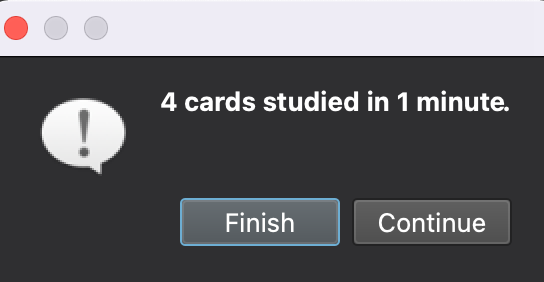
If you lot hit "Finish," information technology takes you lot out of the deck to the deck browser. If you striking "Keep" you enter into another cycle. I would disable this. There are improve Pomodoro timers. The one I use is the Be Focused – Focus Timer available on the Apple store. Another fun option is the Wood timer for your phone. I talk virtually these in my post hither.
Network & Fill-in
Not much to mention hither. I just accept the "on next sync" disabled. Equally I don't like forcing changes in any direction. These settings will automatically sync your Anki occasionally, with images, and automatically sync whenever you open or close Anki.
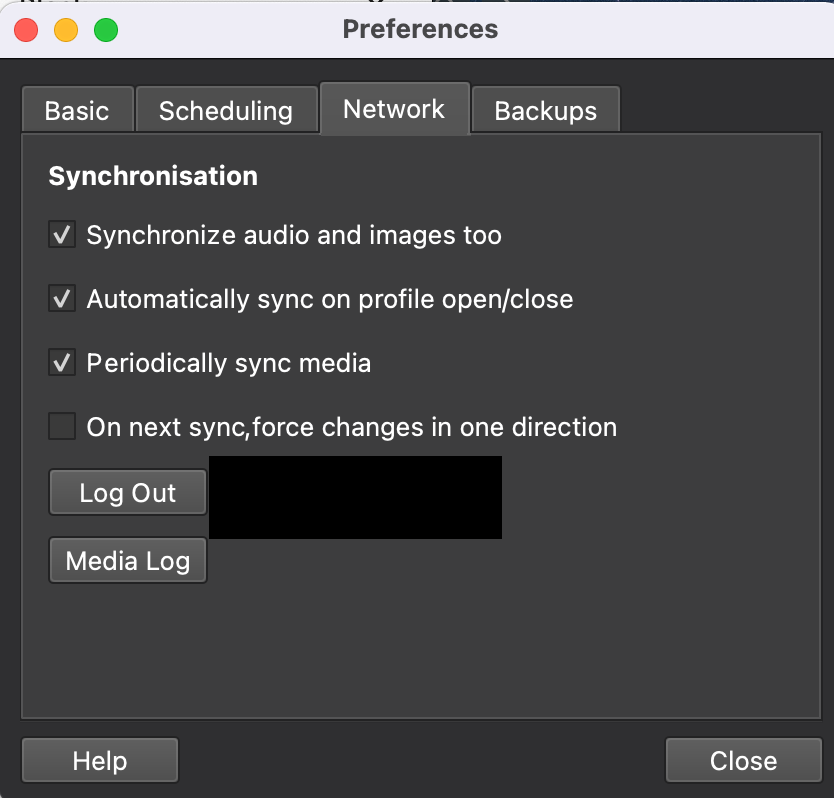
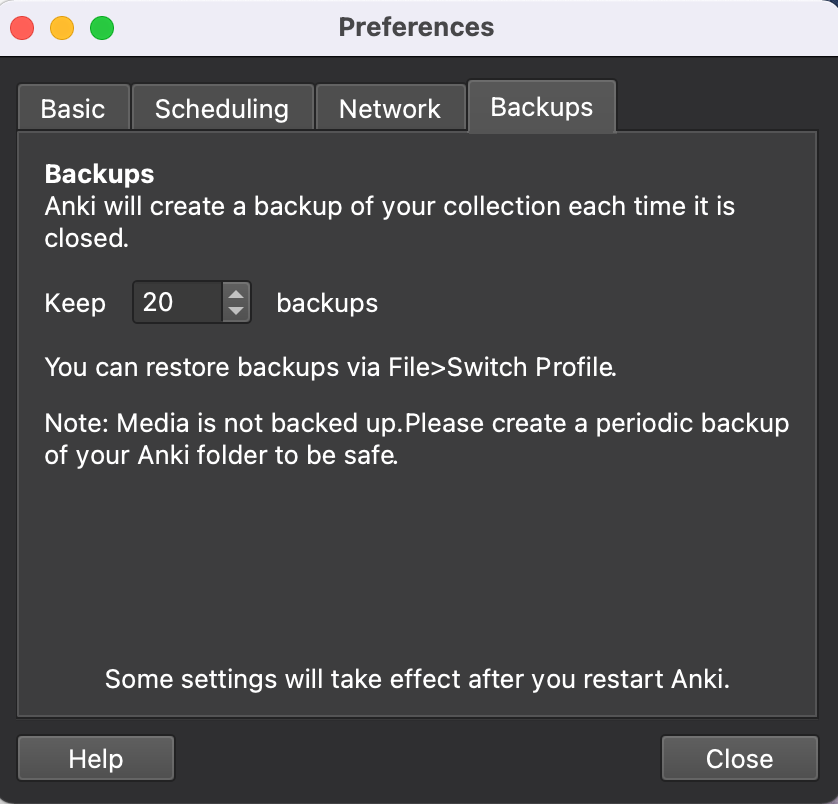
Deck Settings
Now we are on the nigh of import role. The deck settings are going to exist what defines how often you lot run across your cards and, therefore, play a large part in your retentiveness of these cards.
Background Data
If yous want to just skip to the images of my settings click here.
Learning Anki cards tin be separated into ii phases. "Learning" and "Graduated."
When you lot first unsuspend or add a bill of fare it is a new card in the "Learning" stage.
After you lot complete a certain number of "learning steps" (like hitting "good" at solar day 1 and striking "adept" once again at day 3), your carte is "graduated." Dislocated? I was too, permit's explain information technology a little better:
Try and ignore the specific settings, for at present, focus on the "Steps." The "Steps" is your "Learning" stage. I want to give a background of what this all means.
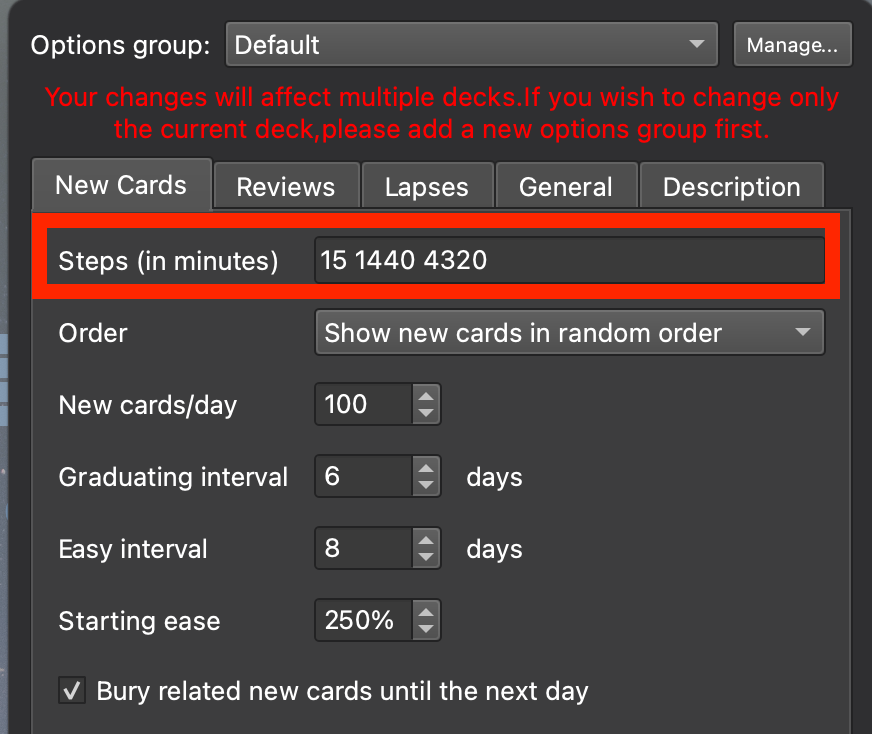
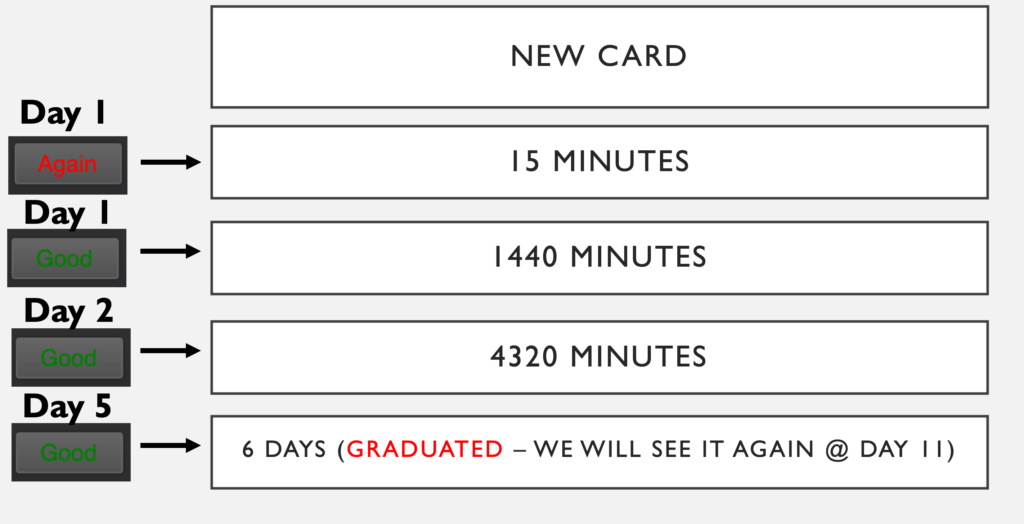
This ways, when y'all are learning a new card y'all will come across information technology at gear up intervals depending on what you select:
- If you lot don't know it and hitting "once more," the menu volition exist shown to y'all in 15 minutes.
- If yous practise know it and hit"proficient," the bill of fare volition be shown to you in ane day (1440 minutes is the number of minutes in i twenty-four hour period)
- On 24-hour interval 2, if you notwithstanding know it and hit "good," the bill of fare will be shown to you again in 3 days (4320 minutes is 3 days) and the card is graduated.
- On day 6 post-learning, the carte du jour is graduated and is subject field to the normal Anki algorithm (which will be explained presently)
- If at whatever point in this "learning phase" you hit "easy" the card will immediately be graduated and sent 8 days into the future. This is the "Piece of cake Interval."
- If at any bespeak in the "learning stage" yous hit "again," the card is sent back to its first "learning step" and you lot will run into that card once again in xv minutes.
So what is the "normal" algorithm of Anki? And how are our graduated cards treated differently? I'm glad you asked.
Usually, when you lot hit "proficient," it is 2.5 ten the current interval. But this only applies to graduated cards . And then if your graduated card was at a 1-day interval, and y'all hit "good," the carte volition show up at 3 days, and and then if you hitting "good" once again, at 7 days, and then on…
But there are more than buttons, every time you striking i of those buttons, "again," "hard," "good," or "easy," Anki applies a different algorithm on that card to determine the next fourth dimension you will run across that bill of fare.
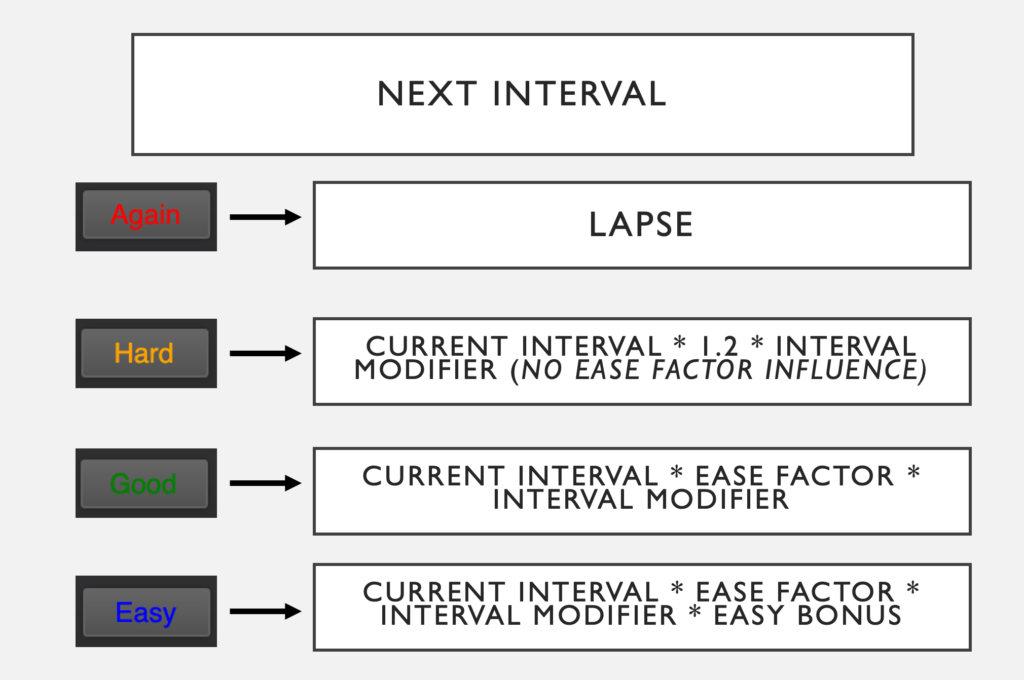
There are many new and confusing terms above, don't worry virtually that yet, I will explain all of them equally the mail goes on. Start by looking at "Lapse."
A lapse is a card you didn't know, that's why you striking "over again," and this bill of fare will enter a new "re-learning" phase. This is what happens whenever you striking "once more." What that means is that you will accept to relearn that information at a pre-set interval (in settings that we will become over after) before you can "re-graduate" that card.
For example, my lapse settings are:

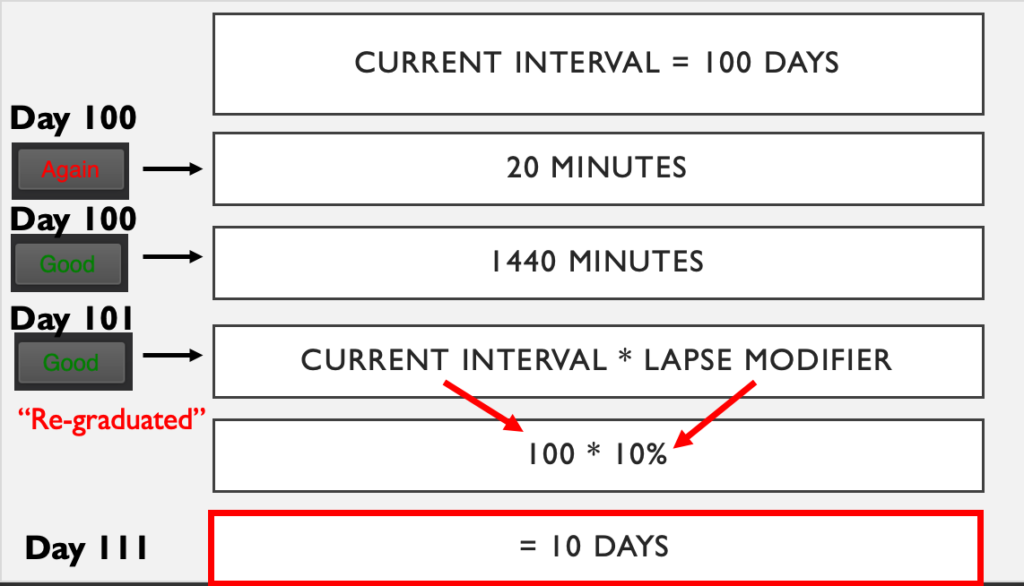
So, if I hit "again" on a carte du jour that was at an interval of 100 days I would be shown the card in 20 minutes. Then, if I hit "good," I will exist shown that card in 1 day. Then, if I hit "good," again I will run across that card in ten days. That menu has "re-graduated."
Why 10 days? Well, my "new interval" is set up to 10%. Then this means, when I lapse or hitting "again" on a menu, and I get through my 20 minutes and i-day re-examination, the card is put back on the schedule at ten% of what information technology was originally. Then it was originally 100 days, so now it is 10 days.
At present for the "hard" role.
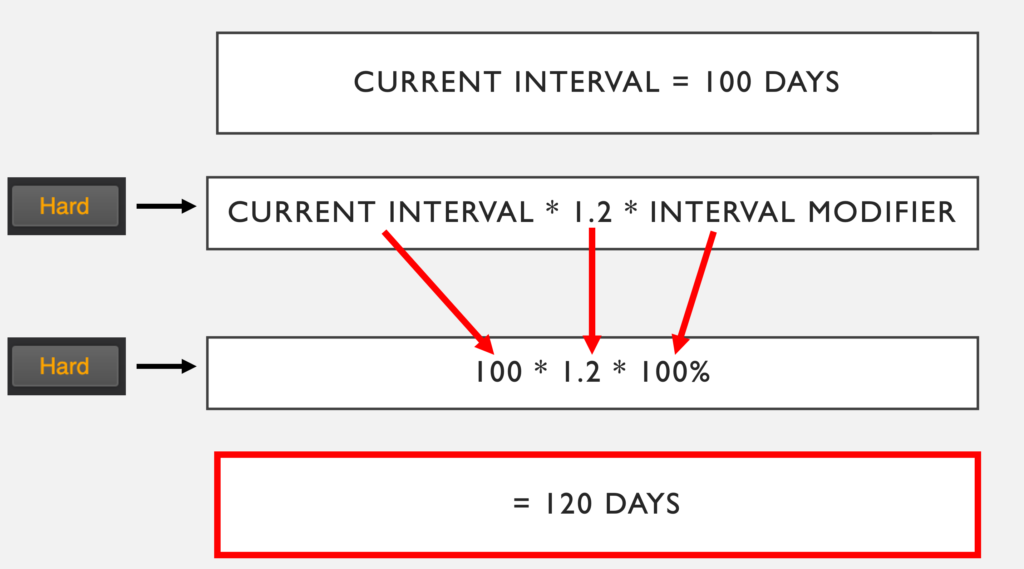
The "hard" button is fairly unproblematic, merely what is this new word, current interval?
The current interval is the interval of the carte is right at present, so let's utilise the 100 days example. And so the current interval is 100 days, which means I saw this card 100 days agone.
1.2 is exactly that, 1.2.
Interval Modifier is a static number you set in the settings. For now, I will simply tell you lot I leave that at 100%. This means it does nil equally 1*1=1 as far every bit I know.
And so, if we striking "hard," the carte will evidence up in 120 days.
Now, onto the "good" part.
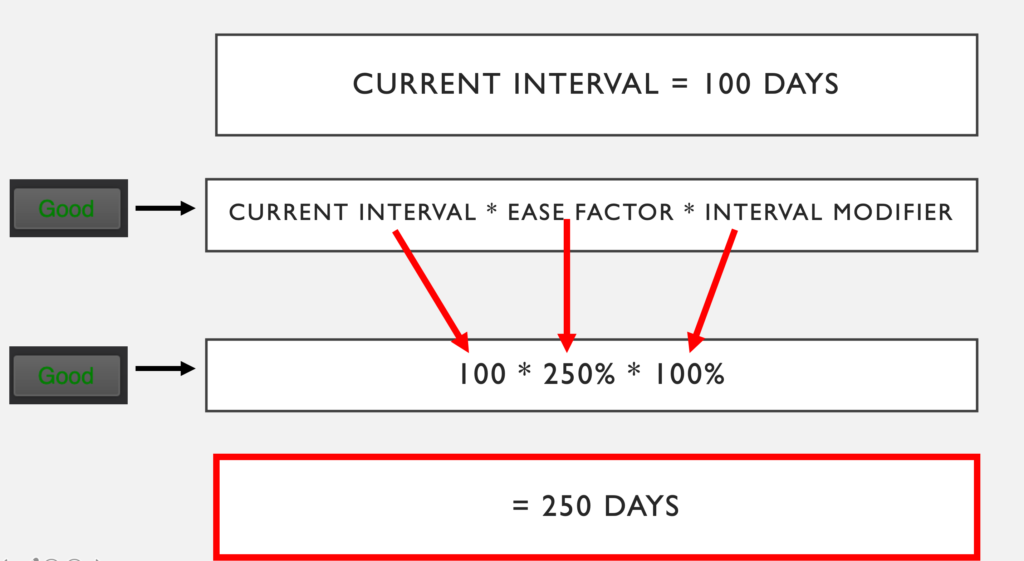
Current Interval we know and Interval Modifier we know, but what is this "Ease Factor?"
The Ease Gene is a unique feature of every bill of fare. It is initially set at 250%. I recommend never changing this. Chiefly, however, Ease Factor will change specific to the card you are doing as you lot answer "again," hard," "good," or "like shooting fish in a barrel." Then when we have a fresh new graduated card, that has left the learning phase, that card is at an Ease Cistron of 250%. Every time we exercise that card, however, depending on our answer, the ease factor is changed as shown below:
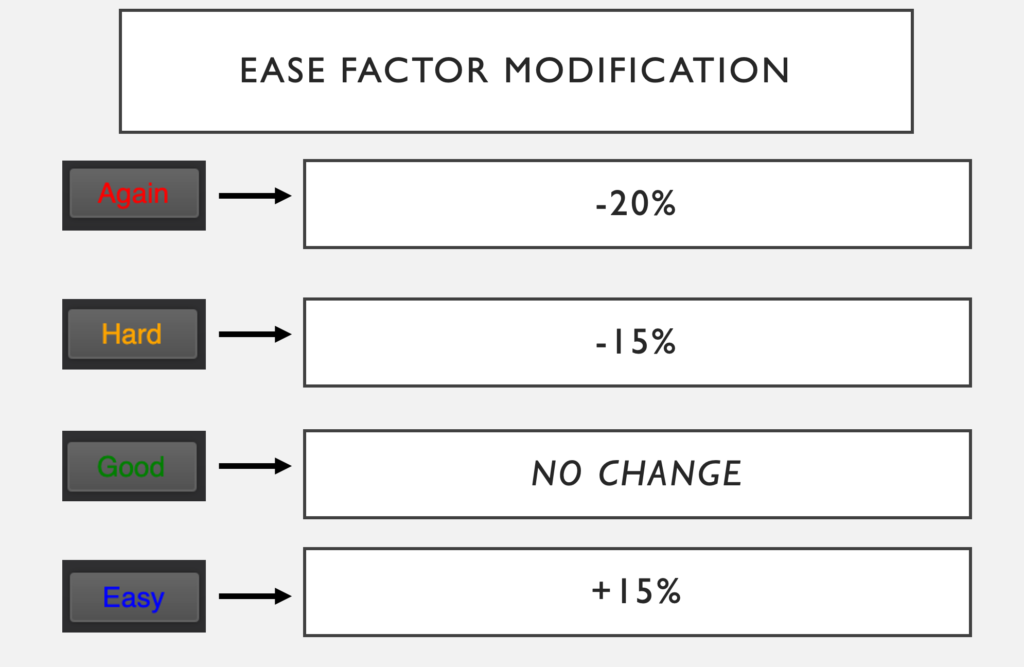
So using our same example of 100 days, if we hit "good" nosotros will see the menu at:
Electric current Interval (100 days) * Interval Modifier (100%) * Ease Cistron (250%)
So we will see that carte du jour in 250 days.
If nosotros hit "hard" or "once again" we would see that card at the interval described earlier, BUT, our Ease Factor for that card is now changed. If we hit "again" the ease cistron is now 230%, if nosotros hit "hard," the Ease Factor is now 235%.
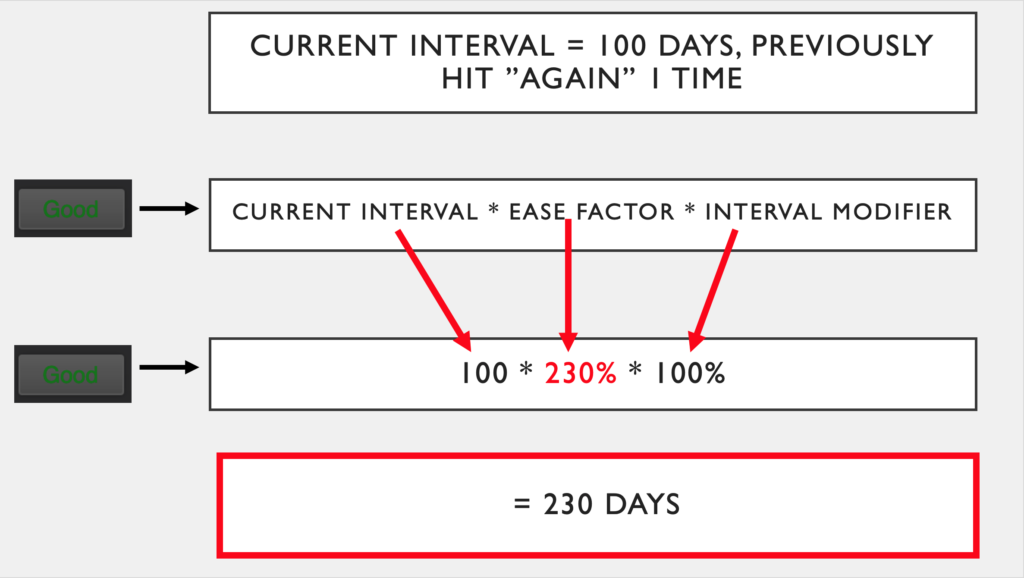
Why is that? Well our Ease Gene is now 230%, and then instead of:
Electric current Interval (100 days) * Interval Modifier (100%) * Ease Factor (250%) = 250 Days
it is:
Electric current Interval (100 days) * Interval Modifier (100%) * Ease Factor ( 230% ) = 230 Days
I hope this makes sense, every bit an understanding of this is important for the settings I have.
Finally, we are on to the "Easy" part.
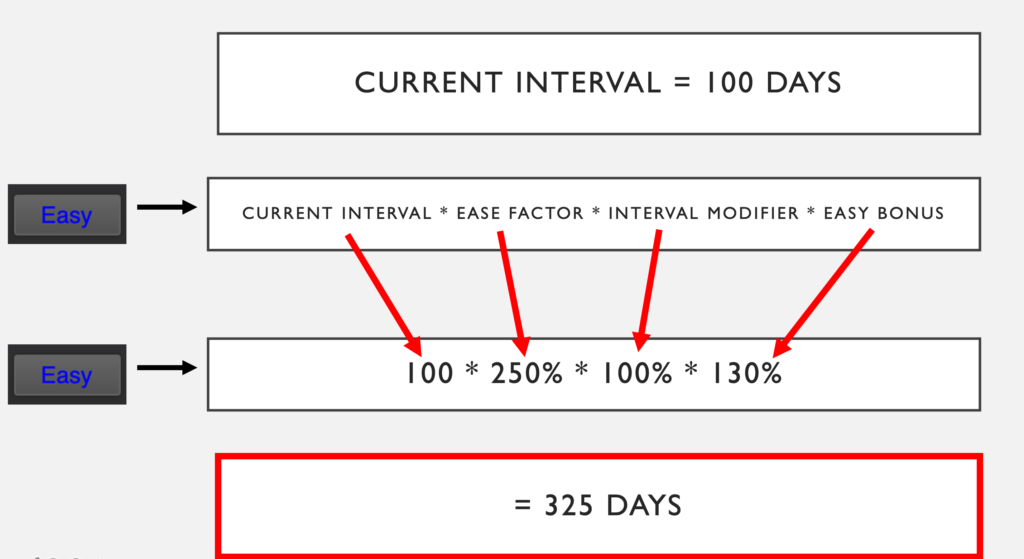
What is "Like shooting fish in a barrel Bonus?"
Easy Bonus is just a static number we can set in the settings, just similar Electric current Interval, that is multiplied to the last interval.
Easy Bonus is normally prepare at 130%.
Ok, well done if y'all got through that. I think that information is necessary if you desire to get the near out of Anki and understand my settings.
Now, onto the skillful stuff, onto my settings.
New Cards
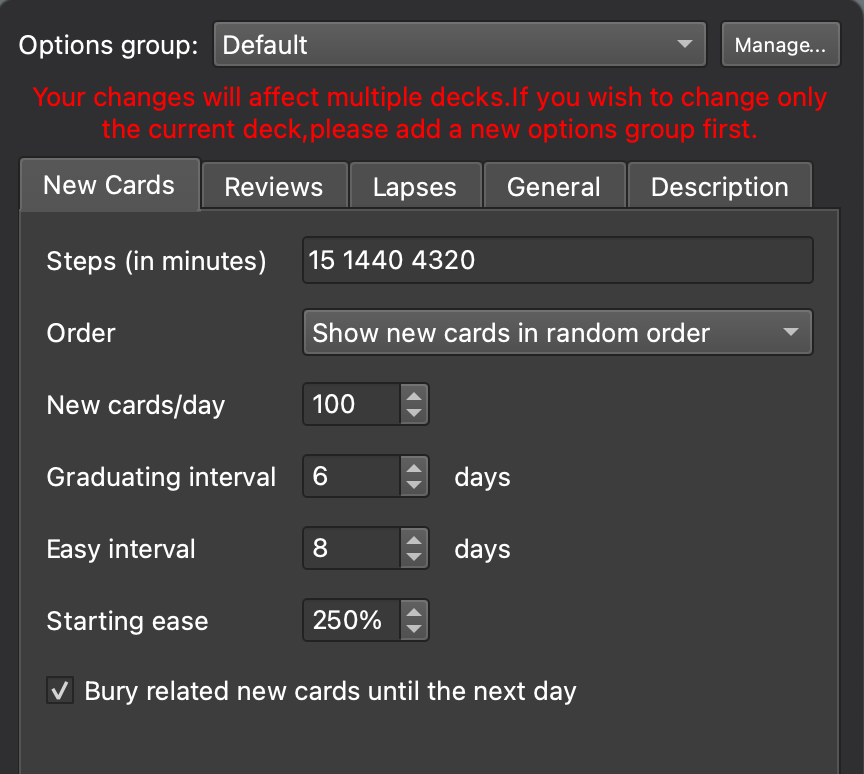
To access this folder go click on the cogwheel next to your deck. I like to go on all my decks the same type, "Default." As you lot can run into all of my decks are nether the "AnKing."
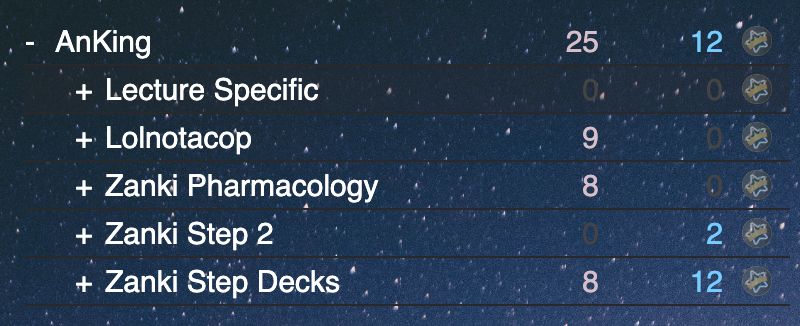
Then, this is the of import office, what are the steps? Well, we talked near it before right. Steps are when your cards are in the "Learning" phase. Here is what I didn't mention earlier when your cards are in the "Learning" phase, they are prophylactic from Ease Factor modification.
In one case cards are "graduated" they are affected by the Ease Factor.
How do we "graduate" cards? Well if nosotros go to the settings of Steps and Graduating Interval, once we hit "good" on our final learning step, the bill of fare is graduated and we will encounter at our "Graduating Interval."
Come across New Card → Striking "good" → Nosotros see the bill of fare 1 twenty-four hour period later → We hit "good" → We now come across the card iii days later → we hit "expert" → the carte du jour is now graduated and we meet it six days later.
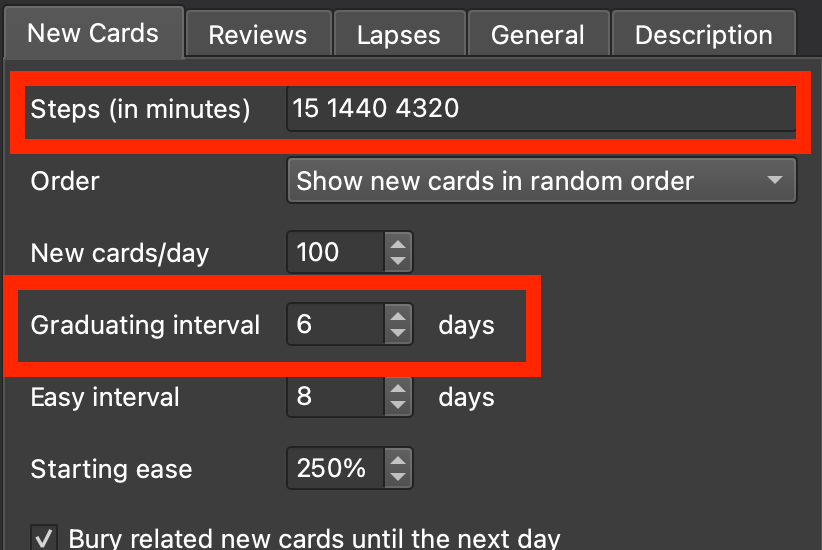
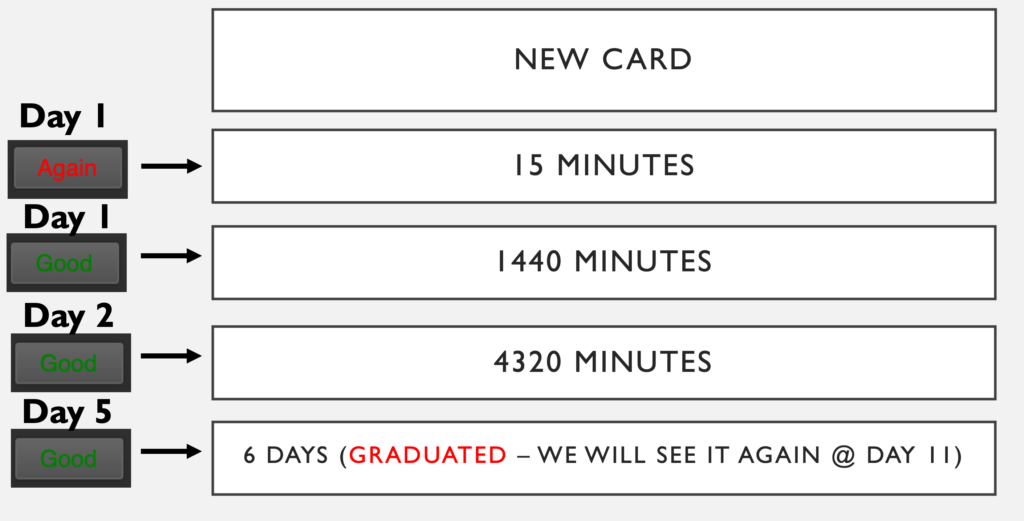
Ok, let'south come back to that mystical Ease Factor. So, while nosotros are doing our learning steps, our Ease Cistron is unchanged. That means that any "agains," or "hards," nosotros select during the "learning phase," up until that final learning step (3 days) DOES NOT modify the Ease Gene.
Then, this means we can hit "once more" on our learning cards all we want up until that final learning pace (at 24-hour interval 5 postal service-learning) without affecting the Ease Factor.
Why is this important? Well, when we are start learning our cards things are still but offset to make sense. It may be a tough mean solar day that 24-hour interval, or maybe your brain is existence funky, or maybe yous simply oasis't learned that topic in a lecture that week even so, or maybe your Outset Aid book is angry with you for not taking out the trash, mutual medical pupil problems.
After we hit "again" on a Graduated card vi times our Ease Factor reaches a minimum of 130%. If this happens to as well many of our cards, nosotros enter something called "ease hell."
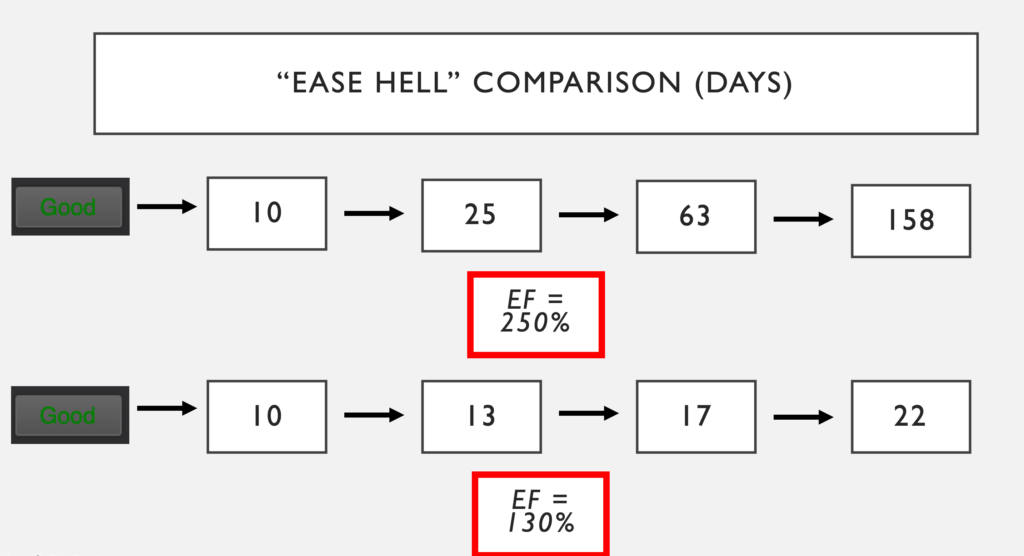
We want to avert "Ease Hell." We want to avoid information technology because we will exist seeing too many cards likewise frequently making Anki unmanageable and inefficient. Anki is an amazing piece of software, simply it's exactly that, software. If we leave the settings as is we are more than likely to enter ease hell.
How I decided on my settings:
All of the points to a higher place hateful that we do not want to be playing with the well-researched algorithm for maximizing memory that decided on this 250% number, which is why nosotros desire some wiggle room in the learning stage (the specifics of the algorithm inquiry was kicked off by Ebbinghaus in 1885, developed upon in 1972 by German language Scientist Sebastian Leitner in 1972, and further developed by SuperMemo most recently1,2,iii. If you want to check out my full postal service on the reasoning behind spaced repetition go here).
This is where my individual preference comes in, and you volition, and should, modify these numbers to maximize your gains and personal preference.
In coming upwards with my learning steps I referenced two "gods" in the field of medical school Anki and that is the AnKing and Conaanaa.
AnKing's Steps: 25 → 1440 (1 Solar day) → Graduated (3 Days)
Conaanaa'due south Steps: 15 → 1440 (one Day) → 8640 (6 Days) → Graduated (15 Days)
Mentionable Option (reddit user – anbu5000): 15 → 1440 → 4320 → 8640 → Graduated (15 days)
My Steps: fifteen → 1440 (1 Day) → 4320 (iii Days) → Graduated (6 Days)
In general, I fall somewhere between the AnKing and Conaanaa's settings. AnKing is harsher, emphasizing high correct rates over more time spent, "put in the extra 30% time for the v% gains." Aiming for mid to high 90s % success rate.
Conaanaa's settings are longer-term, with still high retention, with between 80-90% success rate. His justification beingness the more steps you add the safer you are from messing with the Ease Factor and, therefore, "Ease Hell."
My justification for my settings:
- Nosotros want to, somewhen, starting time messing with this Ease Factor. This is what helps differentiate specific cards that are more challenging to us or easier to us.
- We are trying to maximize our retention in one-2 years, non v+ years (I volition adapt my settings towards Conaanaa's after Stride 1)
- In medical school, nosotros may exist quizzed on something we only learned that week that's why I like to see that card at least twice within 5 days.
Many internet sources support Conaanaa's 80-90% target, however, I had a hard time finding peer-reviewed academic journals in back up of this specific number of 80-90%4.
In my opinion, the AnKing makes a good point that nosotros want to be above 90% for maximizing our Step 1 score, however, I recollect aiming for the mid to loftier 90s makes the number of cards you have to do unmanageable.
And so what did I make up one's mind? I desire to aim for the high 80s, so perhaps 88-xc%. This combines those 2 ideas. These general settings got me in that ballpark, but, actually, I haven't adjusted them for over a year. To fine-melody my way upward to ninety% I adjust my interval modifier, which, remember is applied to all cards. I volition talk about that later, but chop-chop, if my success rate is too low I subtract my interval, seeing the cards more often. If my success rate is likewise high, I increase my interval, seeing the cards less often.
At present (thankfully) things get a picayune more than straightforward. Allow's talk about what "Piece of cake Interval" means.
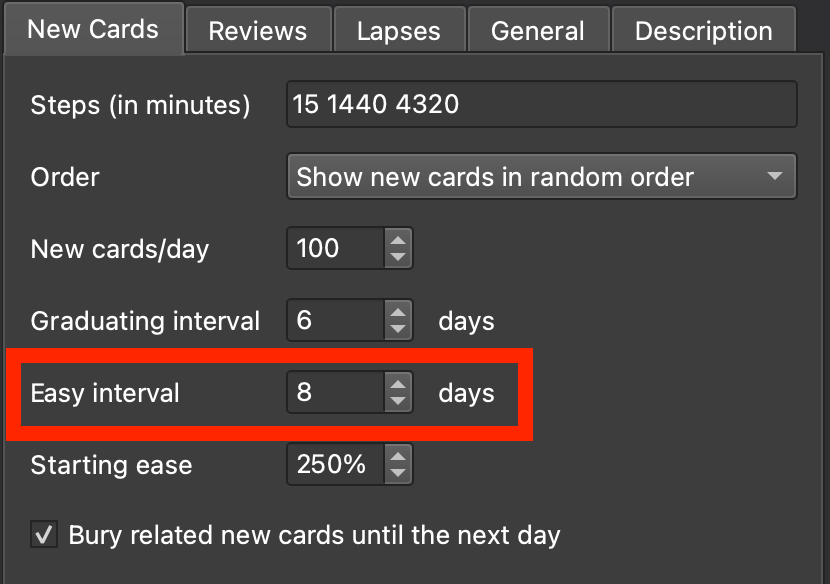
All information technology means, if that at any point during the learning stage, you lot hit "easy" the menu is immediately graduated and shown to you all the same many days later y'all select. I chose 8 days because my graduating interval, of half-dozen days, is a day shorter than normal as if you practical the normal Anki algorithm my graduating interval should be 7 days. But, remember, we want high memory and exposure in that first time seeing that card, which is why I prepare information technology at half dozen days.
If y'all are hitting "easy" you really know that card. I rarely hit like shooting fish in a barrel, so when I do it'due south for skilful reason. I bumped it a day by the normal, so 8 days.
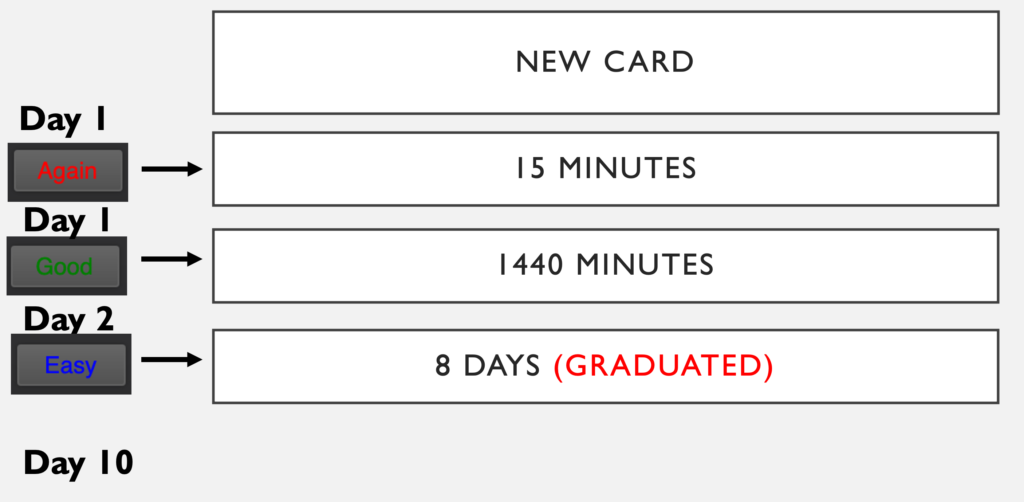
Next is "Starting ease," call up we don't want to bear upon this!! This number was decided upon after many (professional person) experimenters decided upon it1-three. I keep mine at the default 250%.

Adjacent, is "Coffin related cards until the next day." I enable this. This makes cards that are related, as shown beneath, exist separated past i day.

As discussed with doing reviews in random society, I like to practise my new cards in random order as well. This setting is not as important as doing the reviews in random order, merely take found it helps again with avoiding the trap of memorization as we tin remember our new cards by the order that the data is being presented in every bit opposed to actually understanding the information.

What this does is if you have a carte du jour like:
2 + 2 = 4
with a cloze deletion of "ii" and "4," the card would appear to yous twice as:
2 + __ = 4
2 + ii = ___
These two cards could appear on the aforementioned day, and if they are new cards, and you had this setting disabled, they would appear on the aforementioned day. I don't like that. I feel similar I volition just call back the answer of "4" from doing the card before instead of understanding that two + ii = 4.
A major gripe I have with Anki is information technology besides easy to fall into the trap of memorization, most of my settings are trying to avert that trap by emphasizing understanding.
How do we emphasize understanding? Well, I think, nosotros avoid using brusk term retention every bit much as possible. This is why I have my lowest learning footstep at fifteen minutes and why I take this setting enabled.
We are done with New Cards! Well done.
Reviews
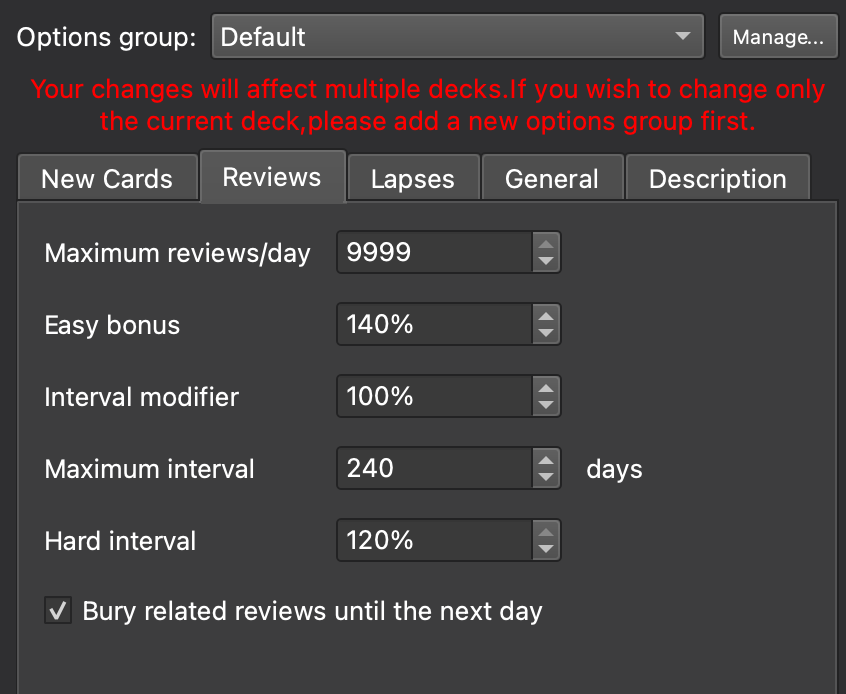
For reviews, the almost of import setting is the starting time 1. Again, we don't want to mess with the Algorithm at all. If cards are being pushed to the next twenty-four hours because we maxed out our reviews, we are messing with the algorithm.
Set your max reviews to 9999 and do all of your reviews, every mean solar day.
Next is Easy bonus. I set Easy bonus to 140%.

Easy Bonus is fairly straightforward, if you call up this image:
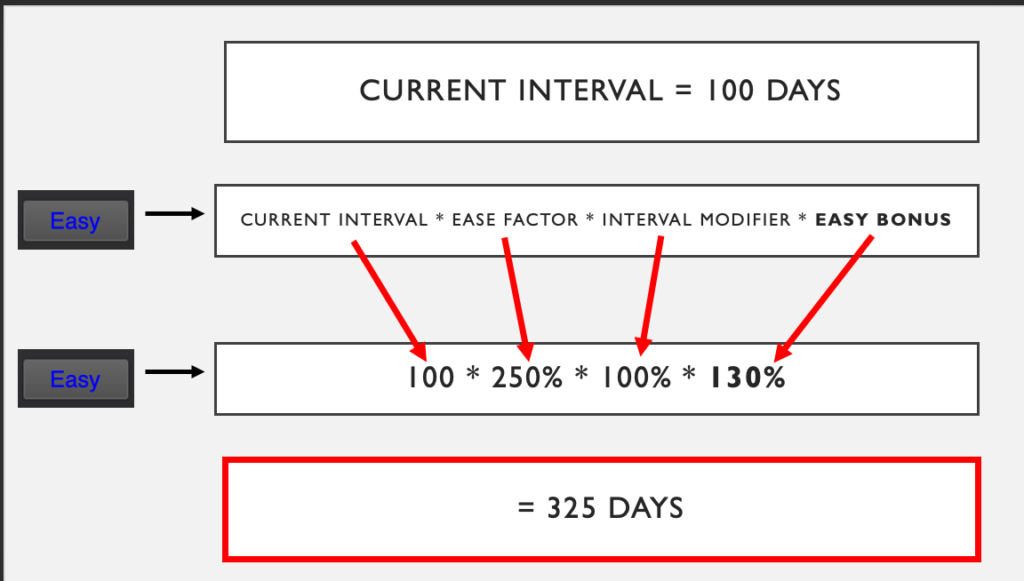
Personally, I rarely hit "Easy." So when I practise information technology means that card was really easy for me. I just bumped the number up from the default "130%" to "140%." This isn't groundbreaking, information technology but works well for me.
Next, we are onto another very important item, however, one that is easier to understand, the interval modifier. I accept changed this number a couple of times, right now, I am happy with it at 100%.

If y'all are striking "easy" and "once again" and "hard" at the perfect times, maybe, you can avert irresolute this number at all. However, sometimes, you are just seeing cards also often or too infrequently. Irresolute this number will change all graduated card intervals as you are doing your Anki cards. Permit's wait at an example assuming you hit good with your Interval Modifier at 100%.
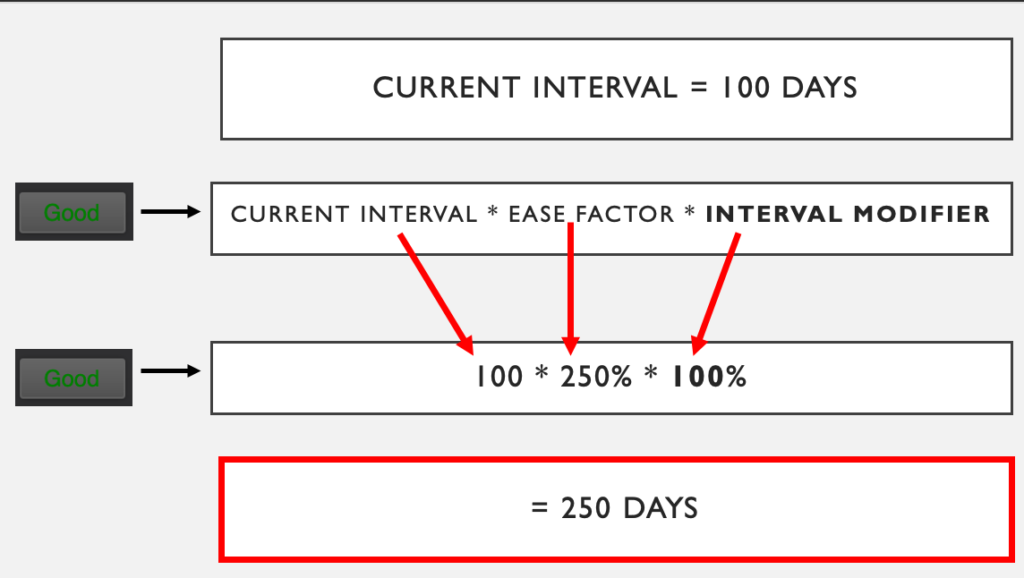
Now if your interval Modifier is l% .
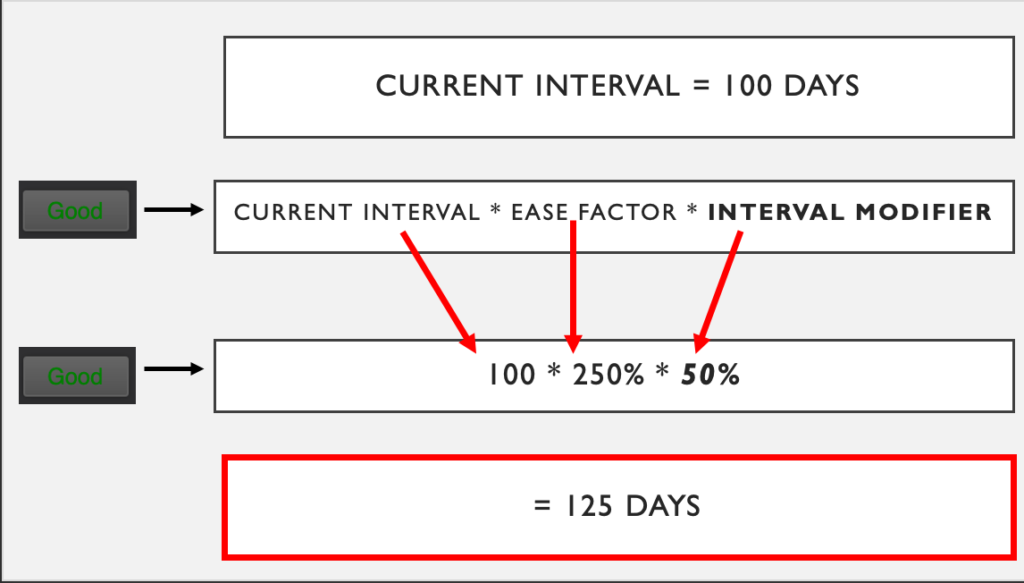
Now permit'south compare the two in the long term.
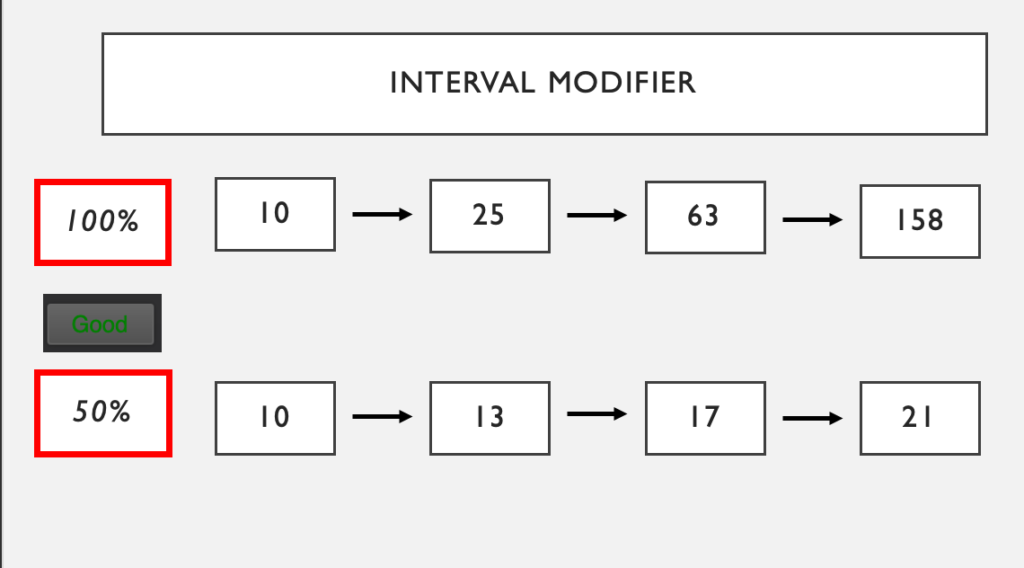
Equally you can meet this makes a large difference, ok, I think y'all know what it does, now let'south talk nearly when to alter information technology. If the following is too confusing/scary for you, it'due south ok, just leave it at 100% and everything should be fine.
I spoke about this earlier, but, in general, I similar to aim for a Success Charge per unit of the very loftier 80s. My reasoning is that I want to score well on Step, we can score well past having a high success rate, however, as we try and push that success rate up the work exponentially increases (something like 30% extra work for 5% gains). Now, that's ok for me, to a signal. I tried pushing over the 90% hump and my card count got besides loftier. Also, many other people seem to emphasize an lxxx-90% success rate. So, like finding merely the right temperature oatmeal, I decided on trying to striking as close to 90% without passing it. I'chiliad doing pretty well with that.

To get this information only download the true retention app → restart Anki → "Shift-Click" Stats on your deck browser.
What I would do, over the past two years, is monthly I would check upwards on this number. If I felt I was seeing too many cards, and perchance pushing by 90%, I would increase my interval modifier by 5% to run into the cards farther apart.
If I felt I was seeing too few cards, and my retentivity charge per unit was dropping to the mid-80s, I would decrease my interval modifier by 5% to see the cards more than frequently.
So what do I propose for you? Well, I am pretty happy with my electric current setup, I don't think it'southward a bad place to aim for at all. Play with that interval modifier, slowly, and carefully and don't rely on statistics from 1 day or fifty-fifty one week.
Next things to talk near the maximum interval.

I will defer to a great post by reddit user u/nicolascuri, merely he says nosotros should never cap our max interval. I agree with him. Unnecssary repetitions are exactly that, unnecessary.
If you lot brand this number likewise small like 3 months, the number piles upward (yellow line). Interestingly subsequently vi months (pink line), for me, the increasing of the max interval doesn't make of a difference via this sumaltion. i year is the orange line.
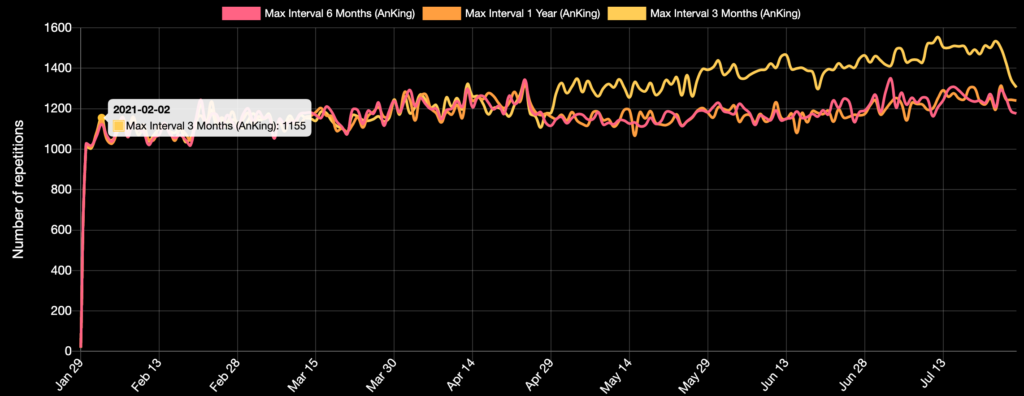
This is using the Anki simulator app which can exist accessed hither
I recommend setting a max of at to the lowest degree 6 months (180 days) and possibly higher if yous want. To be safe, I will officially recommend 240 Days (viii Months) for the first two years of medical school.
Adjacent, permit's talk nearly the hard interval.

I discussed this earlier, but this is just a static number that applies whenever y'all hit difficult on a graduated menu. Don't change this. I rarely hit hard. I don't see any reason why you lot want to adjust this. Just for the sake of spaced repetition…
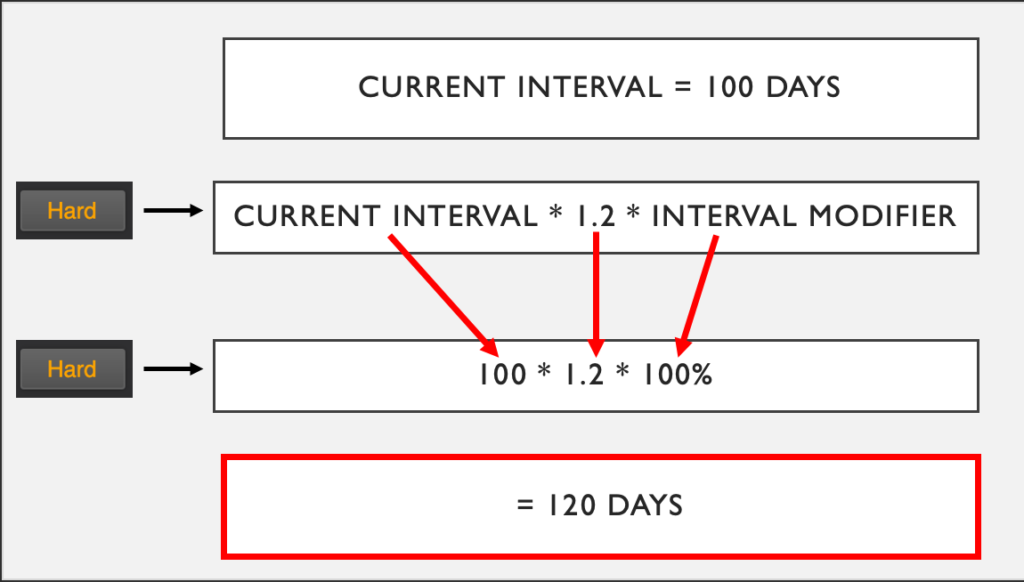
I have bury related reviews until the next day enabled.

As spoke about earlier, I desire to avoid memorization. Let's utilize the "burying" rule to reviews (on graduated cards) also every bit "learning" (on new cards).
We are on the dwelling stretch now! But lapses to practise and we are done.
Lapses
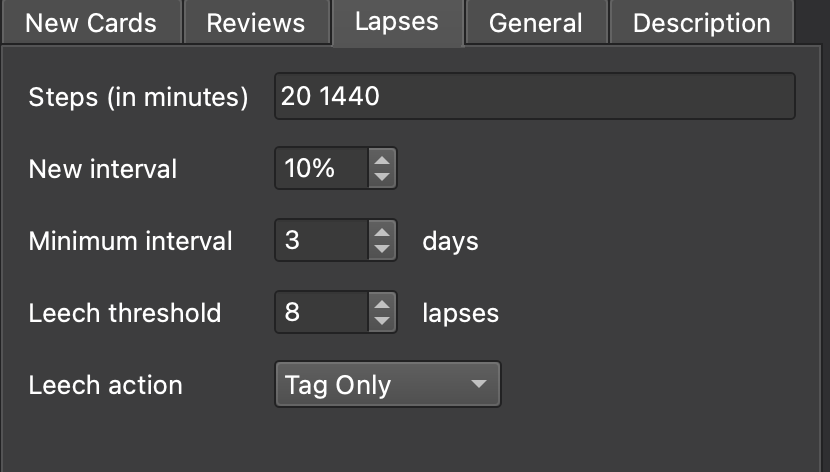
Lapses are what happens when we get a card incorrect. If you think how I described it earlier:
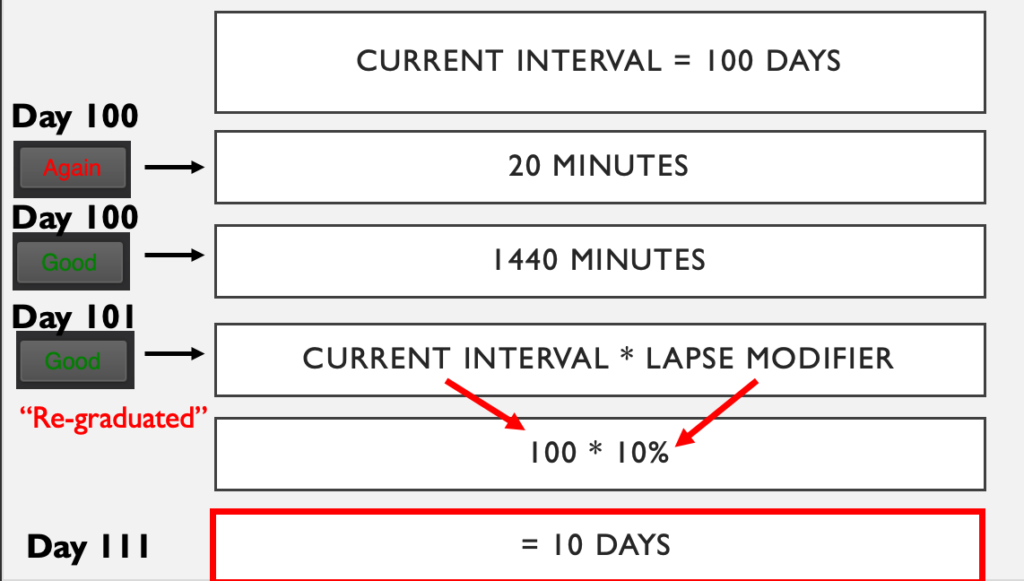

When you get a card wrong it enters "relearning." It is basically the same equally "learning" a card except when you graduate the card its next interval is determined by your new interval %. I put ane less interval on the "relearning" stage because I already learned it.

I have my lapse setting at ten% because when I become a card wrong, I usually really don't know information technology. I well-nigh need to entirely relearn that card. This is the way I designed my settings. I don't have it at 0% because that makes the carte load likewise loftier, and, ordinarily the card will evidence upward too frequently for me.
I experimented with the lxxx% lapse percentage but it was way too high. I would relearn a card with those steps of twenty minutes and 1 twenty-four hour period, and then if a bill of fare had an interval of 100 days, I would run into it again fourscore days later. It was definitely non solid plenty in my heed to exist showed 80 days later, so, what I noticed, is I would become to lxxx days with these cards and I would inevitable hitting "over again," with no understanding of the card whatsoever.
I suggest you set it at 10-thirty%. I like the 10% number.
Ofttimes, nevertheless, 10% of my current interval of a carte du jour drops the adjacent interval to below a mean solar day. That'due south where this setting comes in:

This ways, that say I accept a carte du jour with an interval of ten days, I become this card wrong. ten% of 10 days is 1 24-hour interval. I don't want to be reviewing this bill of fare at one mean solar day → 1 day, that is dizzy, and confronting the algorithm, so I don't.
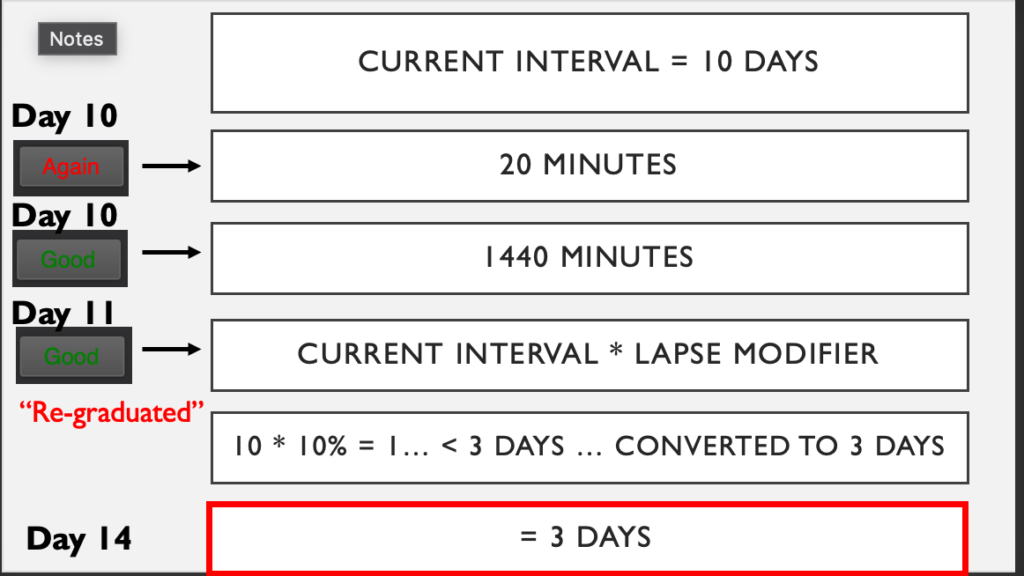
Now, allow's talk about leech threshold and leech action.

What this ways, is if you striking "once more" eight times on a graduated card the card will be tagged as a leech.
I do non think the "suspend" setting is a skillful idea. We want to practice actually well on Stride 1, this ways nosotros want to learn these cards that are a struggle for u.s., non push them to the side.
The other matter to note is that if you have hitting "once again" viii times your card has hit the floor of the Ease Cistron. So your Ease Factor is at 130%. That's OK though, think, we adjusted for the learning stage with our learning steps. And then if the Ease Factor is at 130% at present it is meant to be there, you need to await at this card, and y'all need to keep looking at this menu.
I can track my leeches and time spent on individual cards, about monthly, I volition bank check the cards that are taking me the virtually fourth dimension and accept some time to learn the facts that are my sticking points.
side annotation: if you want to track your leeches, and the fourth dimension spen t on every leech, I suggest you download the advanced browser app, which will allow y'all customize your browser to sort for "time spent" on certain cards.
General
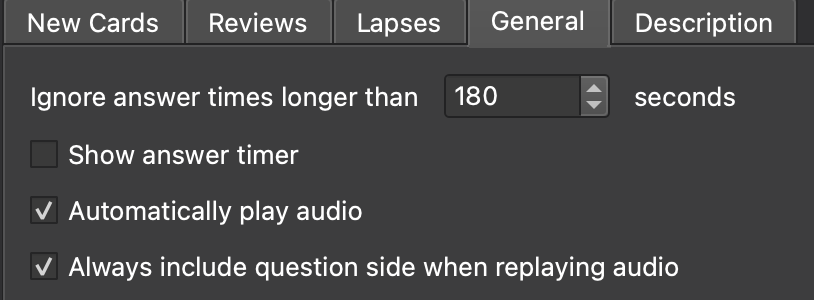
These settings are straightforward.
If I become up from my desk, or await at a card for longer than three minutes, Anki assumes me as "afk" and ignores the answer.
I do not like to show respond time equally it is distracting.
On the few cards that have sound, I like that to play immediately afterwards I answer.
Fuzz Factor
As an extra piece of information, Anki has a built-in "Fuzz Factor." What this means is that, on all cards, a different interval volition be practical to cards from 80-120% of what the interval would be without the fuzz factor regardless of what push button you lot printing.
So when you lot press any button, Anki may give that card an interval of anywhere betwixt 80 and 120 days. This isn't such a huge difference that it's messing with the Anki algorithm. This is just put in place so when yous introduce new cards, you won't have to review all of them on the aforementioned twenty-four hours.
Honestly, for our state of affairs, this doesn't brand much sense as nosotros are doing new cards pretty much every twenty-four hour period, only, if, for example, you did TONS of new cards on ane mean solar day, and not so much on another twenty-four hours, this would help balance the load.
If anyone has used load balancer (which I don't recommend using because load balancer really does mess with the algorithm), this congenital in function is like that.
Terminal Tips
You must exist honest with yourself. "Tip of the natural language" is not expert enough. Hit "again."
If a card is showing upward too much I only hit "easy." If this is happening across the board I think almost changing my interval modifier.
I continuously edit, add images, and do the Feynman Technique with individual cards.
Otherwise, we did it! Cheers for reading and I promise this was helpful.
-Zach
Pictures of My Recommended Settings For Medical School
Work Cited:
- Murre JM, Dros J. Replication and Analysis of Ebbinghaus' Forgetting Curve.PLoS One. 2015;x(7):e0120644. Published 2022 Jul vi. doi:10.1371/journal.pone.0120644
- Leitner, S. 1. (1991).So lernt man lernen: [angewandte Lernpsychologie – ein Weg zum Erfolg] (Sonderausg., 16. Aufl.). Freiburg im Breisgau [u.a.]: Herder.
- http://www.cc.kyoto-su.ac.jp/information/tesl-ej/ej40/m1.html
- https://eshapard.github.io/anki/target-an-80-90-percent-success-charge per unit-in-anki.html
Source: https://zhighley.com/anki-settings/
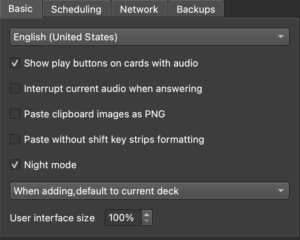
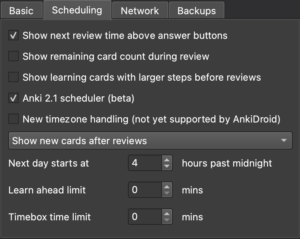
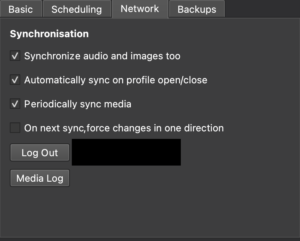
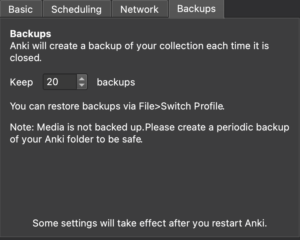
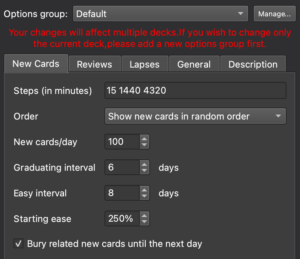
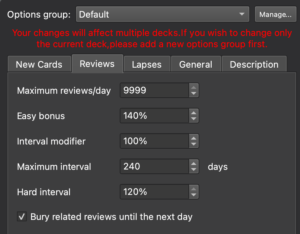
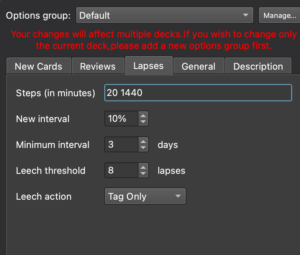
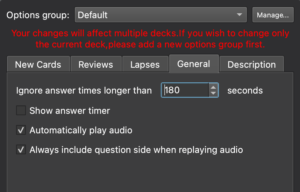
0 Response to "Anki Again Not Going to Learning"
Post a Comment